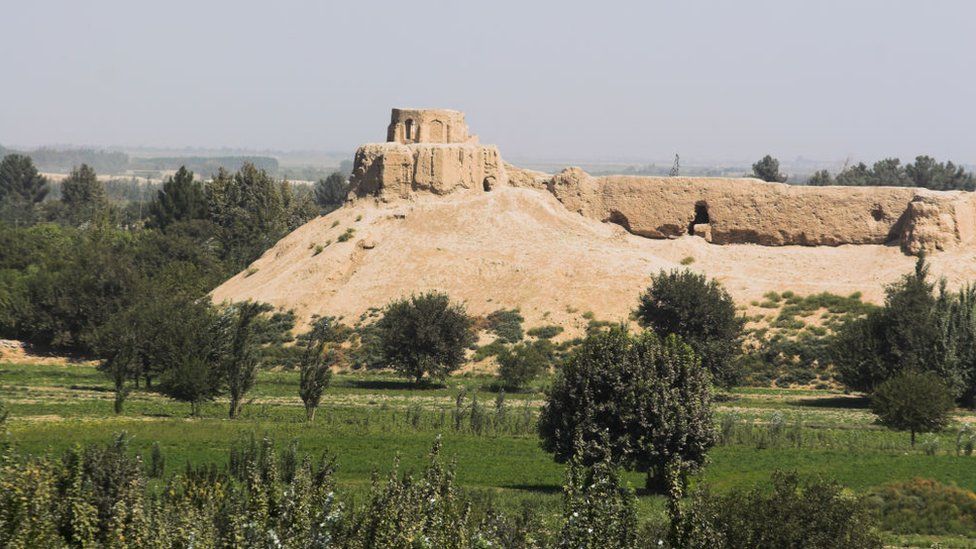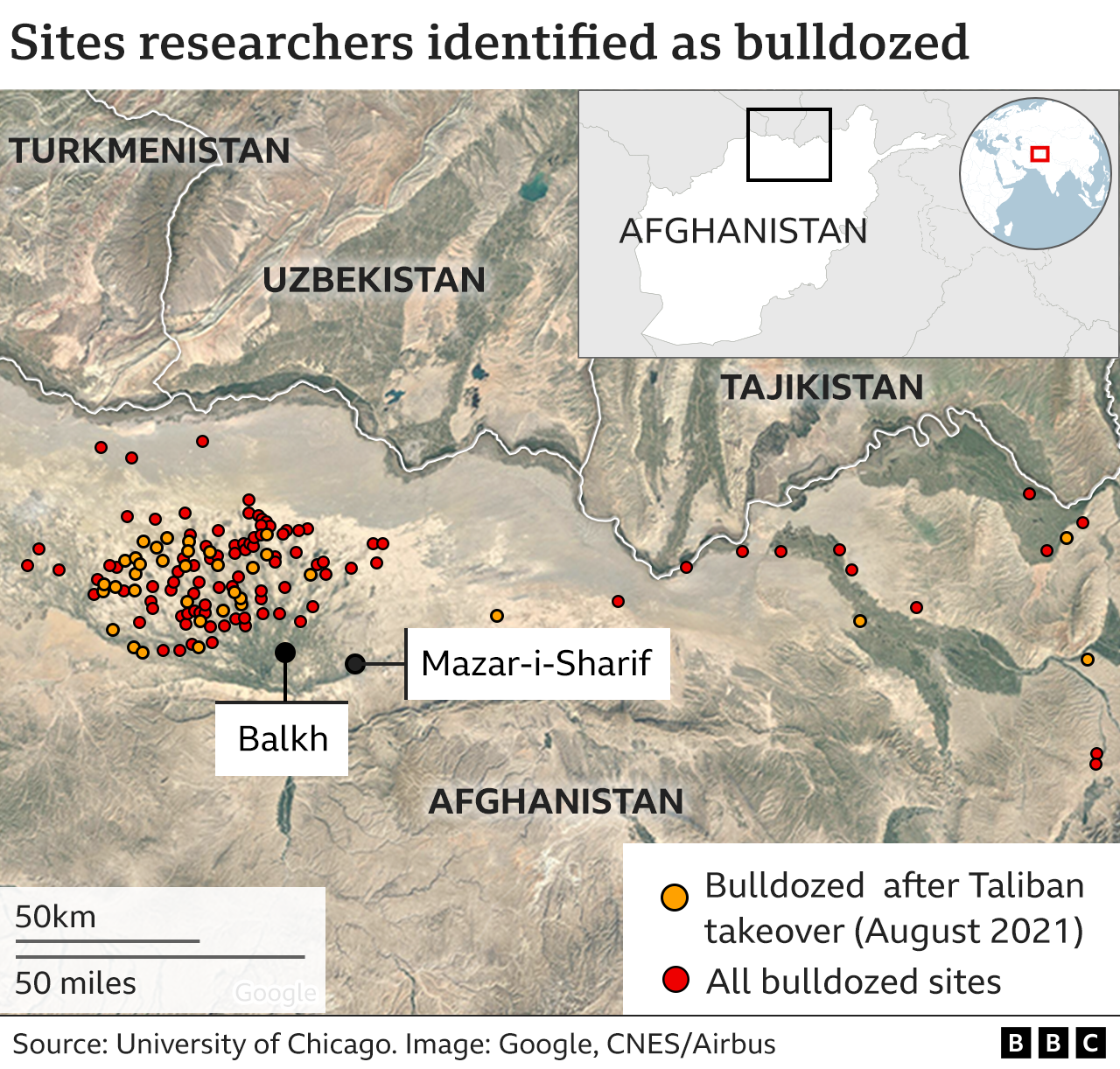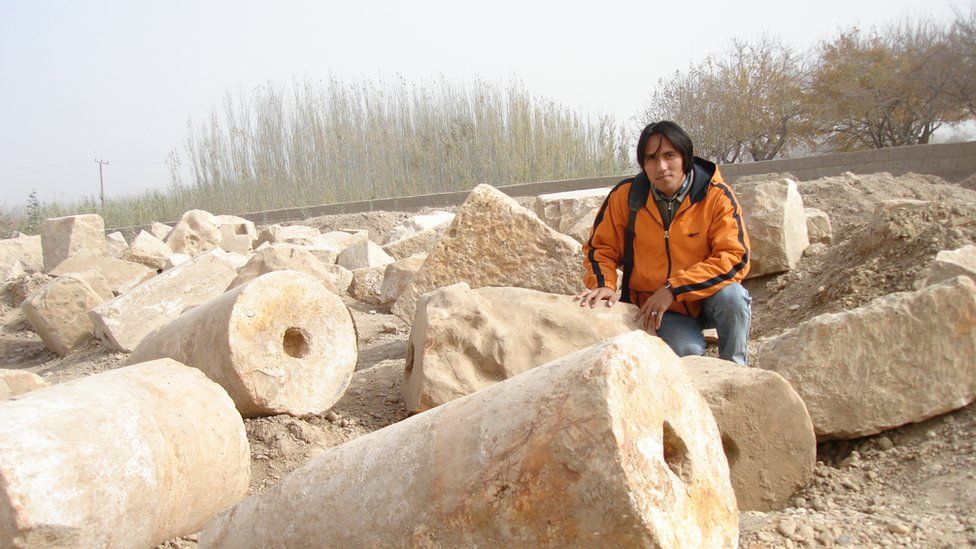Satellite images show damage has continued under the Taliban, according to researchers at Chicago University.
 Image source, Getty Images
Image source, Getty ImagesDozens of archaeological sites in Afghanistan have been bulldozed to allow systematic looting, according to researchers at the University of Chicago.
They say their analysis of satellite photos provides the first definitive photographic evidence that looting patterns that began under the previous government have continued since the Taliban returned to power in 2021.
Ancient settlements dating back to the Late Bronze Age and Iron Age – some earlier than 1000BC – are among those they say have been damaged.
Most of the sites identified are in northern Afghanistan’s Balkh region, which more than two millennia ago was the heartland of Bactria.
It was one of the richest and most populous regions of ancient Afghanistan under the Achaemenid Empire in the 6th Century BC.
By 327BC, Alexander the Great had conquered the region and married a Bactrian woman named Roxana, after defeating the Achaemenid ruler.

Located on a major east-west Silk Route, the region’s central city Bactra – later called Balkh – has been a centre of both the Zoroastrian faith and Buddhist learning. It later became an important Islamic city.
The researchers from the University of Chicago’s Center for Cultural Heritage Preservation have identified more than 29,000 archaeological sites across Afghanistan, helped by satellite imagery and other tools.
But they spotted a new pattern in the Balkh region from 2018 onwards.
They say they have identified specks on the images that they are confident are bulldozers because of the way they appear and disappear over time, and the tracks they leave in their wake.
These freshly bulldozed areas then appear in later images, covered with pits dug by looters, Prof Gil Stein, the centre’s director explained.
“Basically, the people were clearing out vast areas to make it easier to loot the site systematically,” he told me.

His team say 162 ancient settlements were “devastated at an astonishing rate of one a week” between 2018 and 2021, and the practice continued at 37 sites after that, under the Taliban.
The researchers are not publishing the exact locations to avoid giving information to potential looters.
Work documenting many of the sites is in its early stages.
This means researchers simply don’t know what is buried in the sites, which are mainly mounds, fortresses, early roadside inns known as caravanserais and canal systems.
But only 97km (60 miles) away lies Tela Tepe, where a hoard of 2,000-year-old Bactrian gold was discovered in 1978.
The “Hill of Gold” contained 20,000 rare items including gold jewellery, an intricate crown and coins, dubbed the Lost Treasures of Afghanistan.

Image source, Getty Images
“You can unearth layers of a civilisation in each mound,” says Said Reza Huseini, a research fellow at Cambridge University.
Born in Balkh, he spent time in his 20s as a volunteer surveying archaeological sites in northern Afghanistan, including some of those the researchers say have been bulldozed. He was shocked to see the images from the University of Chicago.
“When I hear about it, I feel as if my soul is dying,” he said.
There are no clear answers about who is behind the apparent destruction.
Prof Stein says it is significant that the pattern began under the previous government – led by former President Ashraf Ghani – and continued under the Taliban.
Mr Ghani’s government was weak and did not have full control of some parts of the country.
Balkh, including northern Afghanistan’s largest city Mazar-i-Sharif, was among the first areas to fall to the Taliban before they captured the capital Kabul in August 2021.

Prof Stein believes the sites may be being looted by people who are wealthy and powerful enough to be able to buy or rent earth-moving equipment, and to move it to rural areas “with nobody interfering”.
Mr Huseini says some archaeological sites in the area were being looted before he left the country in 2009.
“No-one could do excavations and digging without the permission of local strongmen and militias,” he told me.
“For them, the historic value is not important, they dig and destroy to see what they can find. I’ve seen it with my own eyes – they even used a soil sieve to check for stuff.”
He says he was once part of efforts to secure archaeological access to an ancient site where a militia commander was planting opium.
Back in 2001, the Taliban caused shock around the world when they blew up the 1,500-year-old Bamiyan Buddhas, once the largest standing Buddha statues in the world, during their first stint in power.
But when they returned two decades later, they said they would respect the country’s ancient heritage.
The Taliban’s acting deputy minister for information and culture, Atiqullah Azizi, rejected the claims that looting is taking place, saying an 800-strong unit has been assigned to look after historic sites.
He told the BBC some organisations had sent images to the ministry regarding “bulldozer movements and people moving soil” but said that “we sent various teams to check the sites and I can reassure you that there hasn’t been a single incident in any of those sites”.

Image source, Said Reza Huseini
The Taliban’s defence ministry also said three people were arrested in September, accused of trying to smuggle a stash of antiquities worth about $27m (£21.4), including statues, mummies, a golden crown, a book and swords.
It says the items were handed over to the national museum and the investigation is continuing.
I shared Mr Azizi’s response with Prof Stein.
He said he couldn’t speculate as to why he denied the looting claims, but added: “We can show there was continuity even across two very different political regimes.”
Prof Stein believes looted artefacts are smuggled out of Afghanistan through Iran, Pakistan and other countries and then end up in Europe, North America, and east Asia.
There is a chance some could be showcased, undated and untitled, in auctions and museums around the world.
He points out it is hard to track them down if they have never been catalogued, but he believes it is important to try – and to protect the locations where many more could be found.
“The heritage of Afghanistan is really part of world heritage and something that honestly belongs to all of us,” Prof Stein says.